Spring WebFlux is the new module introduced in Spring 5. Spring WebFlux is the first step towards reactive programming model in spring framework.
Spring Reactive Programming
If you are new to reactive programming model, then I would highly suggest you to go through following articles to learn about reactive programming.
If you are new to Spring 5, please go through Spring 5 Features.
Spring WebFlux
Spring WebFlux is the alternative to Spring MVC module. Spring WebFlux is used to create fully asynchronous and non-blocking application built on event-loop execution model. Below diagram from Spring Official Documentation provides great insight on comparison of Spring WebFlux to Spring Web MVC.  If you are looking to develop a web application or Rest web service on non-blocking reactive model, then you can look into Spring WebFlux. Spring WebFlux is supported on Tomcat, Jetty, Servlet 3.1+ containers, as well as on non-Servlet runtimes such as Netty and Undertow. Spring WebFlux is built on Project Reactor. Project Reactor is the implementation of Reactive Streams specification. Reactor provides two types:
If you are looking to develop a web application or Rest web service on non-blocking reactive model, then you can look into Spring WebFlux. Spring WebFlux is supported on Tomcat, Jetty, Servlet 3.1+ containers, as well as on non-Servlet runtimes such as Netty and Undertow. Spring WebFlux is built on Project Reactor. Project Reactor is the implementation of Reactive Streams specification. Reactor provides two types:
- Mono: implements Publisher and returns 0 or 1 elements
- Flux: implements Publisher and returns N elements.
Spring WebFlux Hello World Example
Let’s built a simple Spring WebFlux Hello World application. We will create a simple rest web service and use Spring Boot to run it on default Netty server. Our final project structure looks like below image. 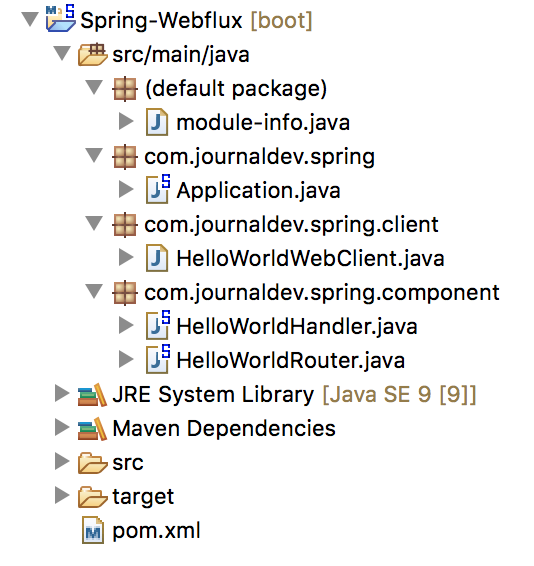 Let’s look into each component of the application one by one.
Let’s look into each component of the application one by one.
Spring WebFlux Maven Dependencies
<project xmlns="https://maven.apache.org/POM/4.0.0" xmlns:xsi="https://www.w3.org/2001/XMLSchema-instance" xsi:schemaLocation="https://maven.apache.org/POM/4.0.0 https://maven.apache.org/xsd/maven-4.0.0.xsd">
<modelVersion>4.0.0</modelVersion>
<groupId>com.journaldev.spring</groupId>
<artifactId>SpringWebflux</artifactId>
<version>0.0.1-SNAPSHOT</version>
<name>Spring WebFlux</name>
<description>Spring WebFlux Example</description>
<properties>
<project.build.sourceEncoding>UTF-8</project.build.sourceEncoding>
<project.reporting.outputEncoding>UTF-8</project.reporting.outputEncoding>
<jdk.version>1.9</jdk.version>
</properties>
<parent>
<groupId>org.springframework.boot</groupId>
<artifactId>spring-boot-starter-parent</artifactId>
<version>2.0.1.RELEASE</version>
<relativePath/> <!-- lookup parent from repository -->
</parent>
<dependencies>
<dependency>
<groupId>org.springframework.boot</groupId>
<artifactId>spring-boot-starter-webflux</artifactId>
</dependency>
<dependency>
<groupId>org.springframework.boot</groupId>
<artifactId>spring-boot-starter-test</artifactId>
<scope>test</scope>
</dependency>
<dependency>
<groupId>io.projectreactor</groupId>
<artifactId>reactor-test</artifactId>
<scope>test</scope>
</dependency>
</dependencies>
<repositories>
<repository>
<id>spring-snapshots</id>
<name>Spring Snapshots</name>
<url>https://repo.spring.io/snapshot</url>
<snapshots>
<enabled>true</enabled>
</snapshots>
</repository>
<repository>
<id>spring-milestones</id>
<name>Spring Milestones</name>
<url>https://repo.spring.io/milestone</url>
<snapshots>
<enabled>false</enabled>
</snapshots>
</repository>
</repositories>
<pluginRepositories>
<pluginRepository>
<id>spring-snapshots</id>
<name>Spring Snapshots</name>
<url>https://repo.spring.io/snapshot</url>
<snapshots>
<enabled>true</enabled>
</snapshots>
</pluginRepository>
<pluginRepository>
<id>spring-milestones</id>
<name>Spring Milestones</name>
<url>https://repo.spring.io/milestone</url>
<snapshots>
<enabled>false</enabled>
</snapshots>
</pluginRepository>
</pluginRepositories>
<build>
<plugins>
<plugin>
<groupId>org.springframework.boot</groupId>
<artifactId>spring-boot-maven-plugin</artifactId>
</plugin>
</plugins>
<pluginManagement>
<plugins>
<plugin>
<groupId>org.apache.maven.plugins</groupId>
<artifactId>maven-compiler-plugin</artifactId>
<version>3.7.0</version>
<configuration>
<source>${jdk.version}</source>
<target>${jdk.version}</target>
</configuration>
</plugin>
</plugins>
</pluginManagement>
</build>
</project>
The most important dependencies are spring-boot-starter-webflux and spring-boot-starter-parent. Some other dependencies are for creating JUnit test cases.
Spring WebFlux Handler
Spring WebFlux Handler method handles the request and returns Mono or Flux as response.
package com.journaldev.spring.component;
import org.springframework.http.MediaType;
import org.springframework.stereotype.Component;
import org.springframework.web.reactive.function.BodyInserters;
import org.springframework.web.reactive.function.server.ServerRequest;
import org.springframework.web.reactive.function.server.ServerResponse;
import reactor.core.publisher.Mono;
@Component
public class HelloWorldHandler {
public Mono<ServerResponse> helloWorld(ServerRequest request) {
return ServerResponse.ok().contentType(MediaType.TEXT_PLAIN)
.body(BodyInserters.fromObject("Hello World!"));
}
}
Notice that reactive component Mono holds the ServerResponse body. Also look at the function chain to set the return content type, response code and body.
Spring WebFlux Router
Router method are used to define routes for the application. These methods return RouterFunction object that also holds ServerResponse body.
package com.journaldev.spring.component;
import org.springframework.context.annotation.Bean;
import org.springframework.context.annotation.Configuration;
import org.springframework.http.MediaType;
import org.springframework.web.reactive.function.server.RequestPredicates;
import org.springframework.web.reactive.function.server.RouterFunction;
import org.springframework.web.reactive.function.server.RouterFunctions;
import org.springframework.web.reactive.function.server.ServerResponse;
@Configuration
public class HelloWorldRouter {
@Bean
public RouterFunction<ServerResponse> routeHelloWorld(HelloWorldHandler helloWorldHandler) {
return RouterFunctions.route(RequestPredicates.GET("/helloWorld")
.and(RequestPredicates.accept(MediaType.TEXT_PLAIN)), helloWorldHandler::helloWorld);
}
}
So we are exposing a GET method for /helloWorld and the client call should accept plain text response.
Spring Boot Application
Let’s configure our simple WebFlux application with Spring Boot.
package com.journaldev.spring;
import org.springframework.boot.SpringApplication;
import org.springframework.boot.autoconfigure.SpringBootApplication;
@SpringBootApplication
public class Application {
public static void main(String[] args) {
SpringApplication.run(Application.class, args);
}
}
If you look at above code, there is nothing related to Spring WebFlux. But Spring Boot will configure our application as Spring WebFlux since we have added dependency of spring-boot-starter-webflux module.
Java 9 Modules Support
Our application is ready to execute on Java 8, but if you are using Java 9 then we also need to add module-info.java class.
module com.journaldev.spring {
requires reactor.core;
requires spring.web;
requires spring.beans;
requires spring.context;
requires spring.webflux;
requires spring.boot;
requires spring.boot.autoconfigure;
exports com.journaldev.spring;
}
Running the Spring WebFlux Spring Boot App
If you have Spring support in Eclipse, then you can run above class as Spring Boot App. 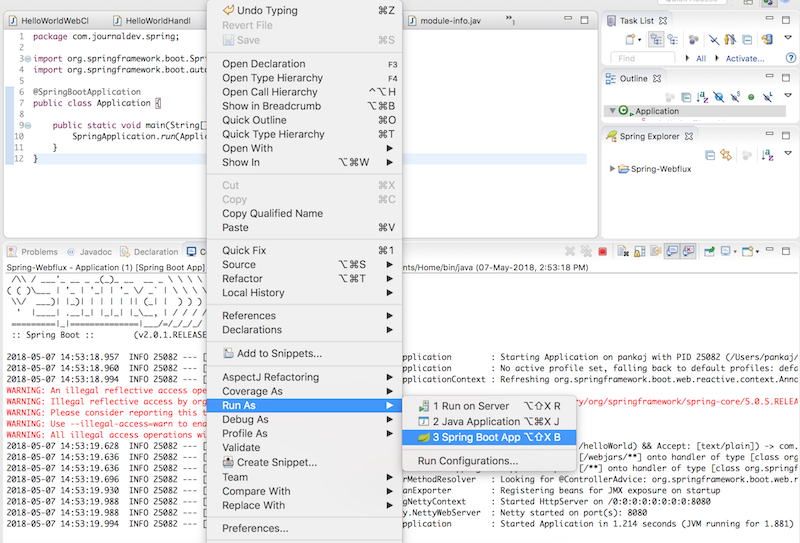 If you like to use command line, then open terminal and run command
If you like to use command line, then open terminal and run command mvn spring-boot:run from the project source directory. Once the app is running, notice following log messages to make sure everything is good with our app. It’s also helpful when you extend this simple app by adding more routes and functionalities.
2018-05-07 15:01:47.893 INFO 25158 --- [ main] o.s.w.r.f.s.s.RouterFunctionMapping : Mapped ((GET && /helloWorld) && Accept: [text/plain]) -> com.journaldev.spring.component.HelloWorldRouter$$Lambda$501/704766954@6eeb5d56
2018-05-07 15:01:48.495 INFO 25158 --- [ctor-http-nio-1] r.ipc.netty.tcp.BlockingNettyContext : Started HttpServer on /0:0:0:0:0:0:0:0:8080
2018-05-07 15:01:48.495 INFO 25158 --- [ main] o.s.b.web.embedded.netty.NettyWebServer : Netty started on port(s): 8080
2018-05-07 15:01:48.501 INFO 25158 --- [ main] com.journaldev.spring.Application : Started Application in 1.86 seconds (JVM running for 5.542)
It’s clear from logs that our app is running on Netty server on port 8080. Let’s go ahead and test our application.
Spring WebFlux App Test
We can test our app with various methods.
-
Using CURL command
$ curl https://localhost:8080/helloWorld Hello World! $ -
Launch URL in Browser
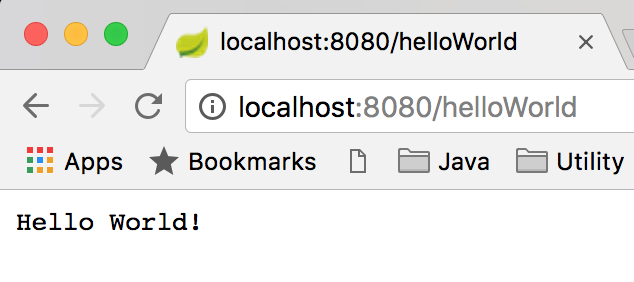
-
Using WebTestClient from Spring 5 Here is a JUnit test program to test our Rest web service using
WebTestClientfrom Spring 5 reactive web.package com.journaldev.spring; import org.junit.Test; import org.junit.runner.RunWith; import org.springframework.beans.factory.annotation.Autowired; import org.springframework.boot.test.context.SpringBootTest; import org.springframework.http.MediaType; import org.springframework.test.context.junit4.SpringRunner; import org.springframework.test.web.reactive.server.WebTestClient; @RunWith(SpringRunner.class) @SpringBootTest(webEnvironment = SpringBootTest.WebEnvironment.RANDOM_PORT) public class SpringWebFluxTest { @Autowired private WebTestClient webTestClient; @Test public void testHelloWorld() { webTestClient .get().uri("/helloWorld") // GET method and URI .accept(MediaType.TEXT_PLAIN) //setting ACCEPT-Content .exchange() //gives access to response .expectStatus().isOk() //checking if response is OK .expectBody(String.class).isEqualTo("Hello World!"); // checking for response type and message } }Run it a JUnit test case and it should pass with flying colors.
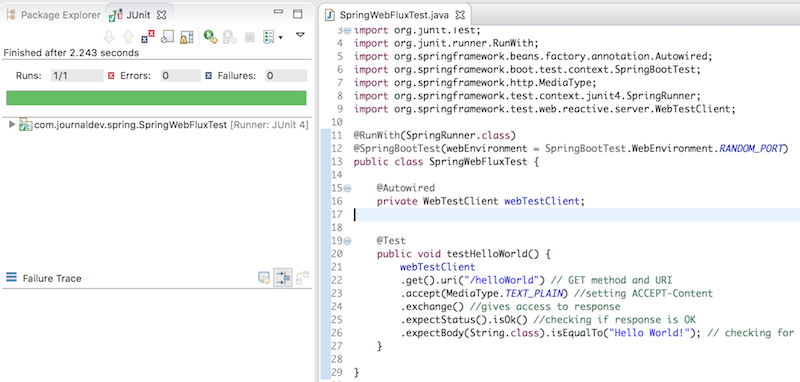
-
Using WebClient from Spring Web Reactive We can also use
WebClientto call the REST web service.package com.journaldev.spring.client; import org.springframework.http.MediaType; import org.springframework.web.reactive.function.client.ClientResponse; import org.springframework.web.reactive.function.client.WebClient; import reactor.core.publisher.Mono; public class HelloWorldWebClient { public static void main(String args[]) { WebClient client = WebClient.create("https://localhost:8080"); Mono<ClientResponse> result = client.get() .uri("/helloWorld") .accept(MediaType.TEXT_PLAIN) .exchange(); System.out.println("Result = " + result.flatMap(res -> res.bodyToMono(String.class)).block()); } }Just run it as a simple java application and you should see the proper output with a lot of debug messages.
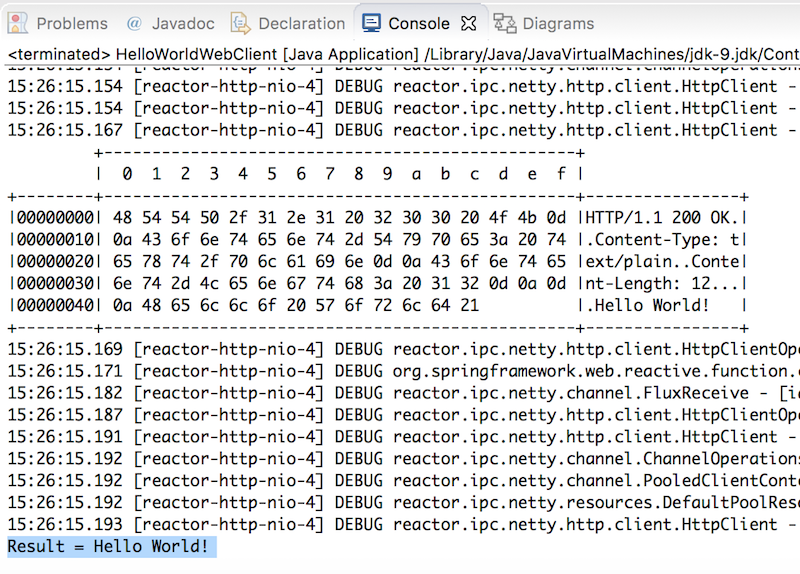
Summary
In this post we learned about Spring WebFlux and how to build a hello world reactive Restful web service. It’s good to see that popular frameworks such as Spring are rooting for reactive programming model. But we have a lot to cover because if all your dependencies are not reactive and non-blocking then your application is also not truly reactive. For example, relational database vendors doesn’t have reactive drivers because they depend on JDBC, that is not reactive. Hence Hibernate API is also non-reactive. So if you are using relational databases then you can’t built a truly reactive application, yet. I am hopeful that it will change sooner than later.
You can download the project code from my GitHub Repository.
Reference: Official Documentation
Source:
https://www.digitalocean.com/community/tutorials/spring-webflux-reactive-programming













